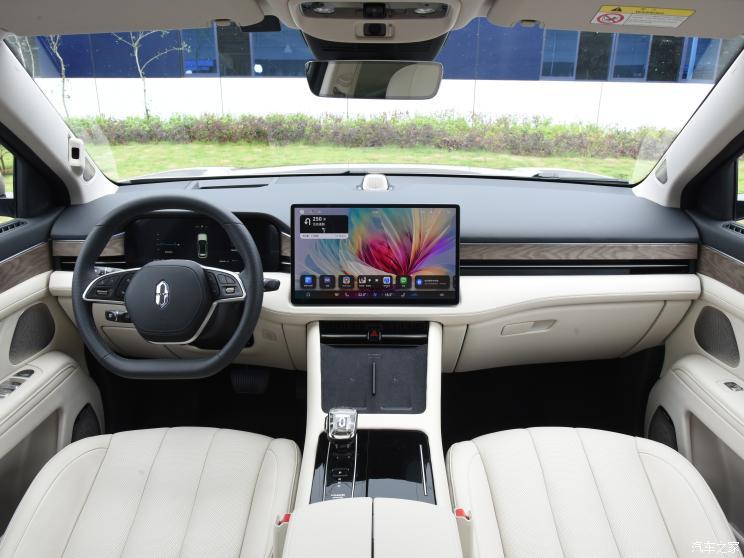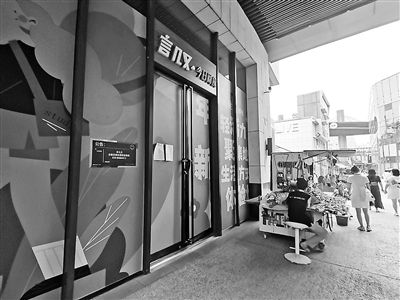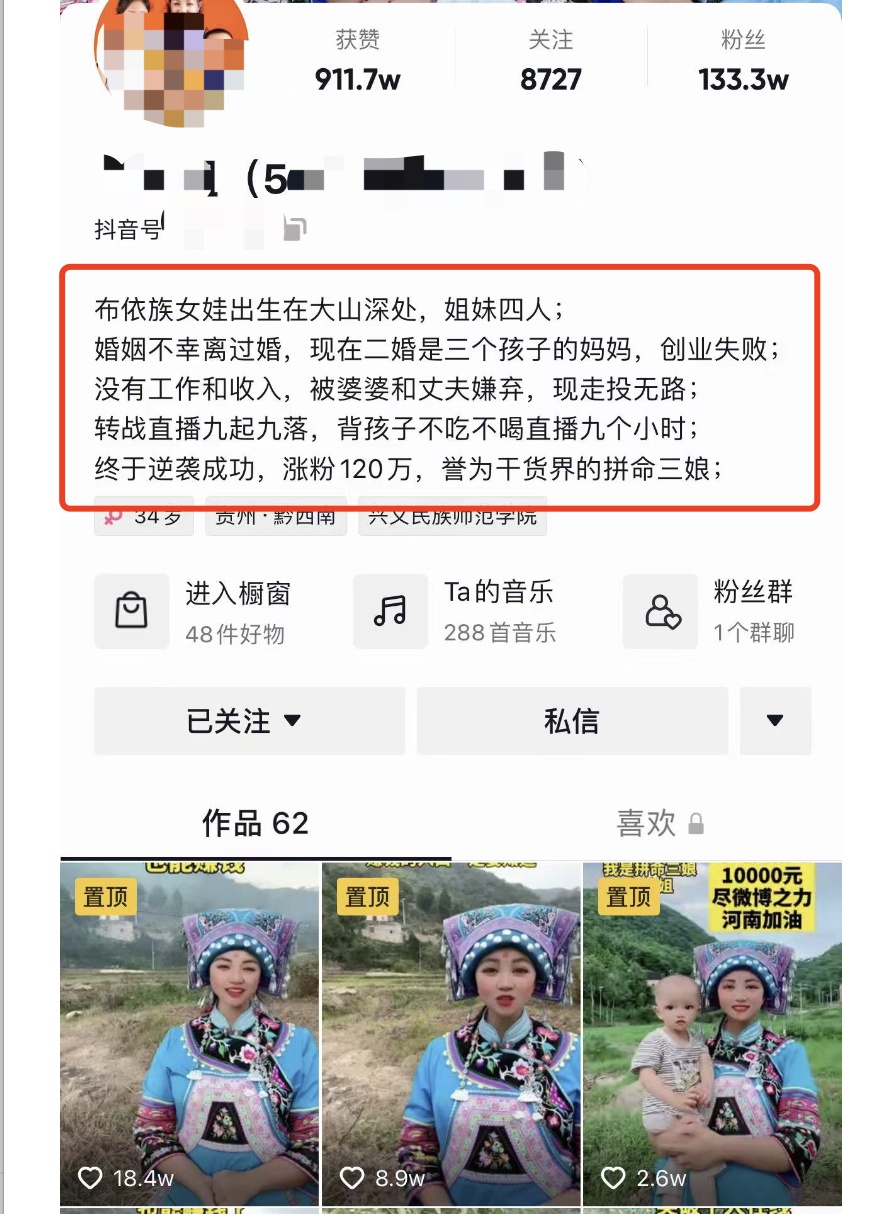News in 2023
1. On October 13th, Guo Ming: The shipment of Xiaomi’s first car is expected to be 50,000-60,000 units, and the price is estimated to be less than 300,000 yuan.
On October 13th, Tianfeng International analyst Guo Ming posted a message on the Medium platform this afternoon, analyzing Xiaomi’s mobile phone and automobile business.
Guo Ming mentioned that the current sales of Huawei’s new M7 exceed expectations, because its manufacturing shows a high degree of industrial division of labor, which symbolizes that the competition focus of China’s electric vehicle market has begun to shift to autonomous driving, software, marketing and channels. Such a new competition pattern will help Xiaomi enter the automobile market.
When talking about the progress and planning of Xiaomi’s first car, Guo Ming said that the new car is expected to be put on sale in 2024, with an estimated shipment of 50,000-60,000 units. It will take autonomous driving, software ecology, 800V fast charging and power configuration as "key selling points" and the estimated price is less than 300,000 RMB. If the price is closer to 250,000 or even lower than 250,000, the shipment volume "should have room for repair".
Guo Ming pointed out that Xiaomi Automobile has two unique competitive advantages in the long run: it can be integrated with existing ecosystems including operating system, App, mobile phone and IoT hardware; Sales channels are all over overseas markets, and Xiaomi’s status as a "world-renowned enterprise" is conducive to the future growth of automobile business overseas.
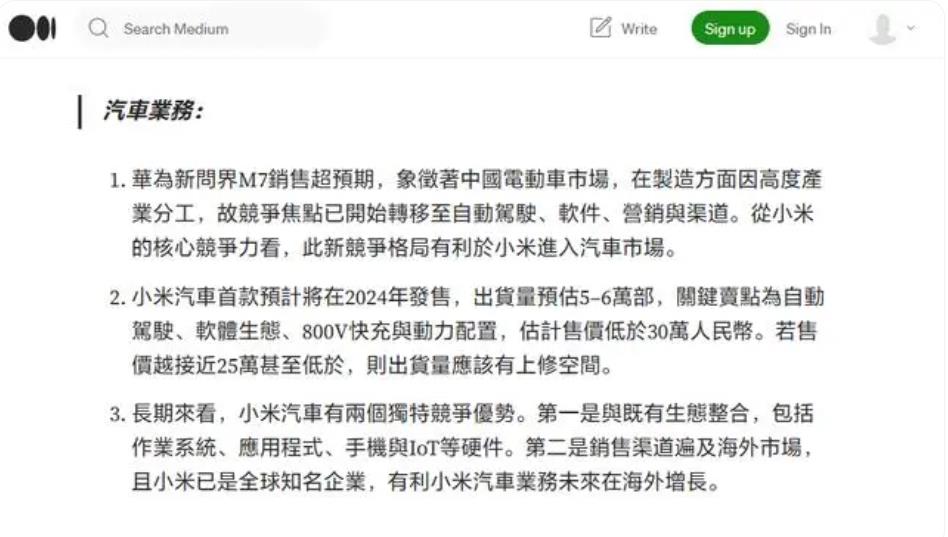
Second, on October 12, the news said that Xiaomi Automobile and
Chery and Brilliance Auto are discussing production cooperation and are trying to get approval from the Ministry of Industry and Information Technology.
According to informed sources, Xiaomi has held talks with some car companies on potential production cooperation relations, among which several car manufacturers include Brilliance Auto and Chery Automobile. The above-mentioned person also revealed that Xiaomi Group is still trying to obtain the relevant approval from the Ministry of Industry and Information Technology, and discussions with other automakers are still in progress, and it is "not sure" that any cooperative relationship can be realized. Xiaomi Group declined to comment on this matter, while Brilliance and Chery did not respond to requests for comment.
Last year, it was reported that Xiaomi Automobile was negotiating with BAIC Group to jointly produce electric vehicles.
In August this year, according to media reports, Xiaomi has been approved by the National Development and Reform Commission to produce electric vehicles. According to people familiar with the matter, the National Development and Reform Commission (NDRC), which is responsible for supervising the new investment and production capacity of China’s automobile industry, approved Beijing-based Xiaomi Company to produce electric vehicles earlier this month. Xiaomi is the fourth enterprise approved by the NDRC since the end of 2017.
However, Xiaomi still needs approval from the Ministry of Industry and Information Technology, which is responsible for evaluating the technical and safety requirements of new car manufacturers and models.
Welfare of this article: Pay attention to [Zhou Zhi Xing] WeChat official account, reply "millet"to get the PDF version of this article.
3. On October 10th, Xiaomi Automobile announced the patent of charging car, which can improve the automatic charging degree of electric vehicles.
Tianyancha App shows that on October 10th, the patent of "charging car and charging method" applied by Xiaomi Automobile Technology Co., Ltd. was announced.
The patent abstract shows that the charging vehicle includes a battery compartment, a wireless charging device and an automatic driving system, wherein the battery compartment is used for loading batteries, the wireless charging device is used for wirelessly transmitting the electric energy of the batteries to the electric vehicle, and the automatic driving system is used for controlling the charging vehicle to travel to a preset relative position with the electric vehicle, and the wireless charging device can wirelessly transmit the electric energy of the batteries to the electric vehicle in the relative position. The invention improves the automatic degree of electric vehicle charging and reduces the complexity of the charging process.
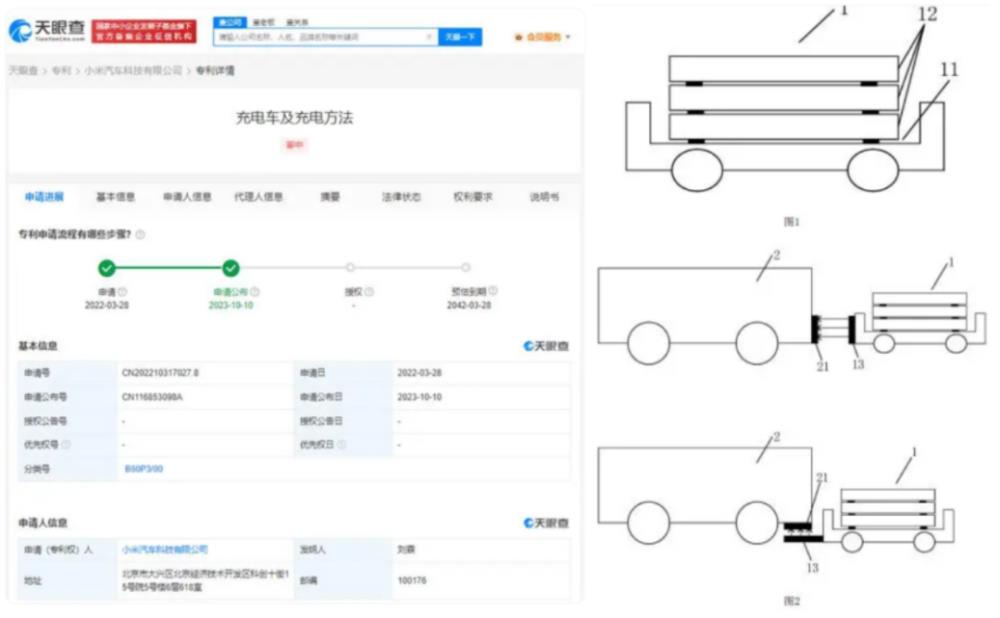
4. On October 10, the release conference or file of Xiaomi Auto will be released on October 31 at the National Centre for the Performing Arts.
The Xiaomi Auto Conference or File will be released on October 31st at the National Centre for the Performing Arts. In addition to Xiaomi 14 series mobile phones, this release also includes Xiaomi’s completely self-developed MIOS operating system and Xiaomi Auto.
?
5. On October 10th,
Tesla sued Bingling Intelligent for infringing technical secrets, which is owned by Xiaomi.
According to Tianyancha’s hearing information, on October 10th, Tesla (Shanghai) Co., Ltd., as the plaintiff, sued Bingling Intelligent Technology (Changzhou) Co., Ltd. in Shanghai Intellectual Property Court for "infringement of technical secrets and unfair competition disputes". During his tenure, Gu Mou, a former Tesla R&D personnel, used his position to download a large number of Tesla vehicle technical secrets in violation of regulations, and privately provided technical services for Bingling Intelligent Technology (Changzhou) Co., Ltd., allegedly revealing Tesla’s technical secrets.
After investigation, Tesla dismissed Gu in September 2022 and decided to file a lawsuit with Gu and Bingling Technology. The case is currently under trial.
Just in March of this year, Bingling Intelligent Technology has just undergone industrial and commercial changes. Beijing Xiaomi Zhizao Equity Investment Fund Partnership (Limited Partnership) became the second largest shareholder of Bingling Technology, holding 11.86%.
6. On October 9, the "Xiaomi Racing" game WeChat official account was renamed "Xiaomi Automobile", and Xiao Ai revealed that there would be an exclusive car control App.
WeChat official account of Xiaomi Racing Game has been changed to Xiaomi Automobile today, and the main body has also become Xiaomi Automobile Technology Co., Ltd.. In addition, Xiao Ai revealed that users can bind vehicles through the Xiaomi car App of the mobile phone to support remote control of the car.
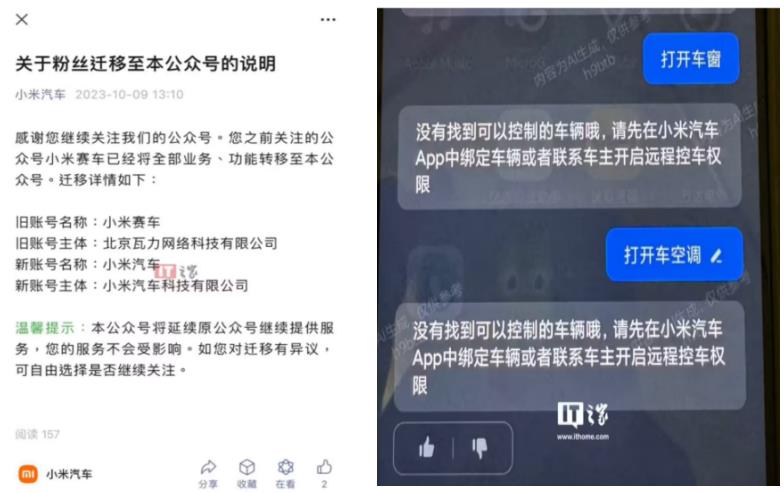
7. On October 9, the layout of the suspected Xiaomi Automobile Factory was exposed, with 6 workshops covering a huge area.
A digital blogger has released a layout plan of a suspected Xiaomi automobile factory. As can be seen from the picture, Xiaomi Automobile has six workshops, namely, die casting workshop, stamping workshop, body workshop, painting workshop, assembly workshop and battery workshop. In addition, North Gate 1 is equipped with two commercial vehicle parking areas. In addition, there are two buildings in Xiaomi Automobile Factory, and there is a test track next to the building. On the whole, the factory covers a huge area.
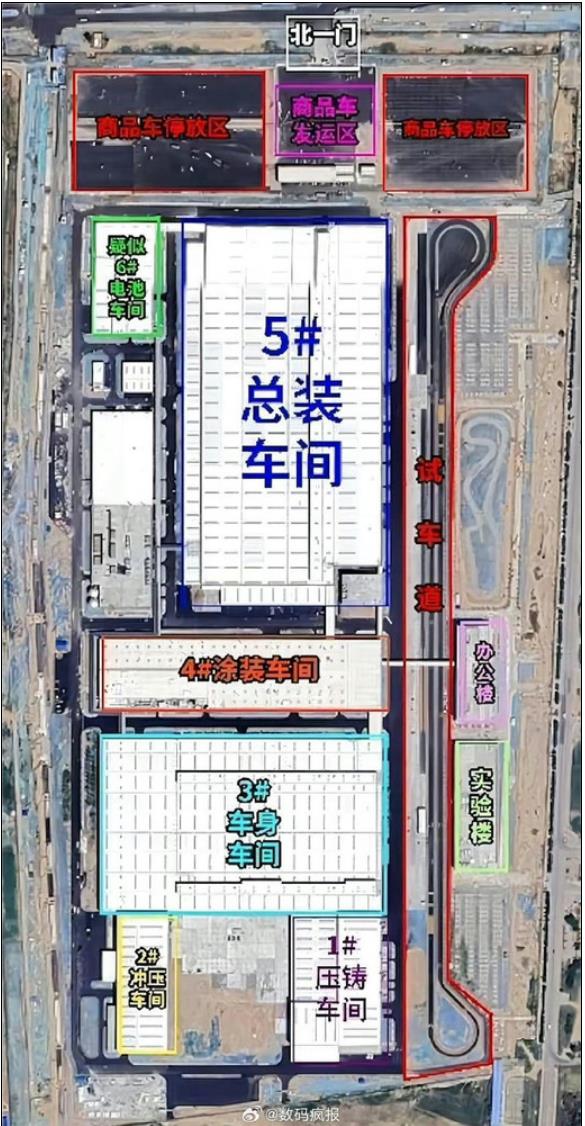
8. On October 9, Xiaomi’s self-developed operating system MIOS is coming, which will provide support for Xiaomi’s car.
On October 9th, Digital Blogger @ Digital Chat Station said: "It is basically confirmed that MIUI 14 will be the last official big version of MIUI". It is reported that Xiaomi’s self-developed operating system MIOS will provide support for Xiaomi’s car, and mobile phones and Internet of Things devices can also be used, similar to the full platform coverage in HarmonyOS.

9. On October 2, Xiaomi official website hinted that Xiaomi Automobile is expected to launch extended-range models.
On October 2nd, the news came that several positions related to automobiles were quietly launched on Xiaomi’s recruitment official website page. It is worth noting that these positions were all related to extended-range automobiles. Including extended range system design and development, fuel system engineer, exhaust system engineer and other positions.
According to sources, Xiaomi Automobile currently has multiple platforms to simultaneously promote research and development. The first-generation platform will be launched next year, and the second-generation platform is planned to be launched in 2025. These two platforms should belong to pure electric platforms. From the time schedule, the launch node of Xiaomi extended-range models may be behind the second-generation platform.
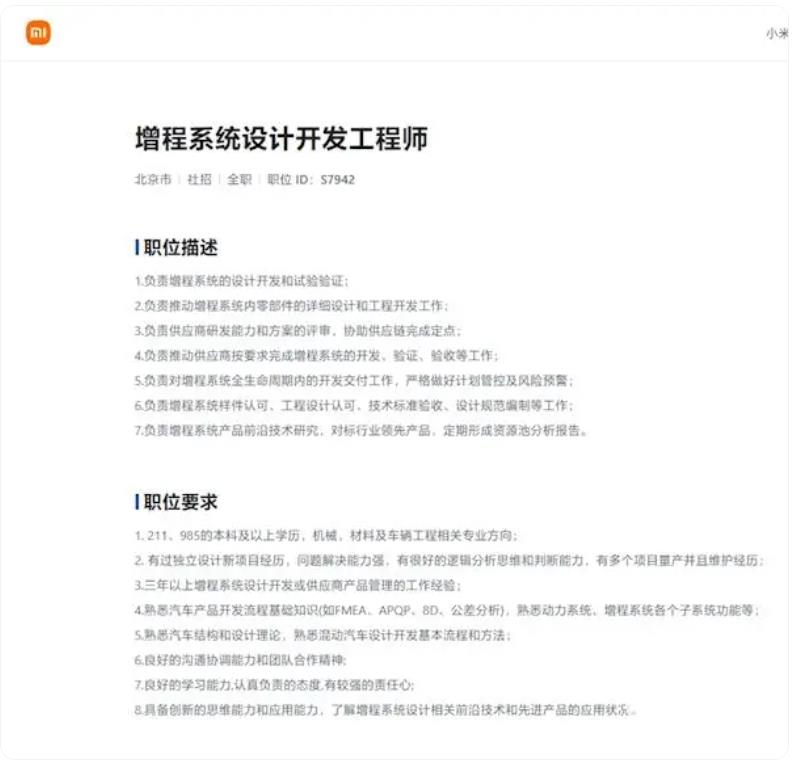
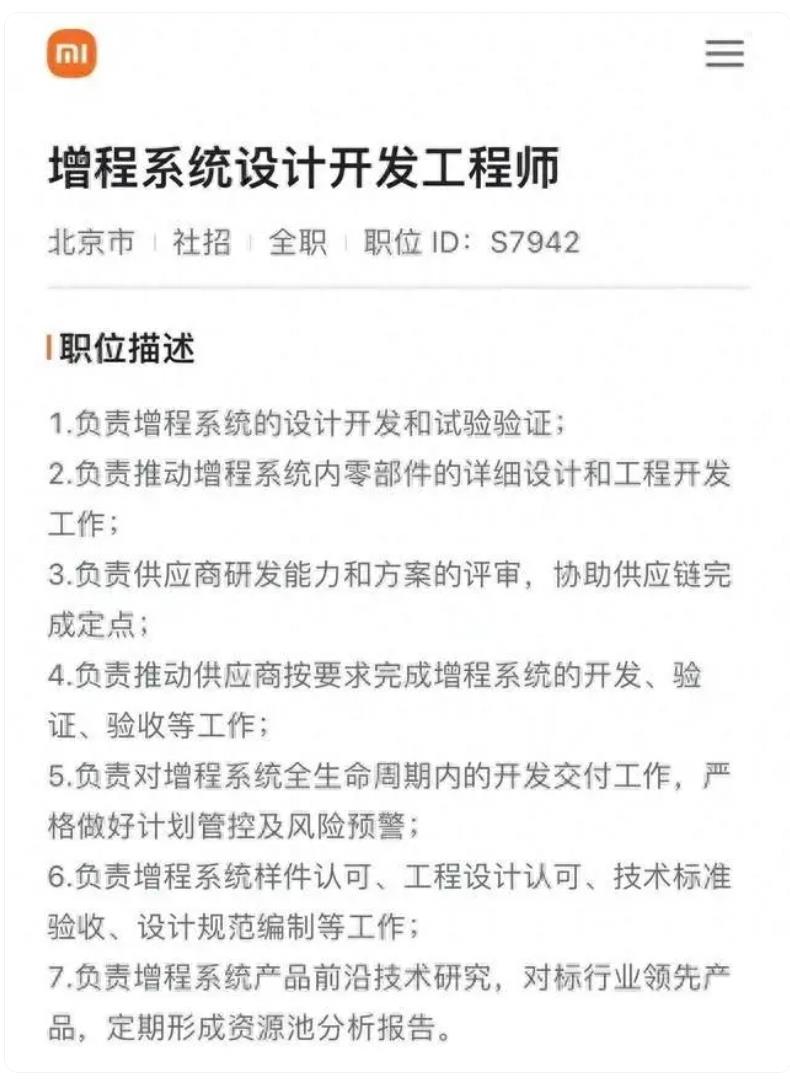
In October and February, MIOS, Snapdragon 8295 and CarPlay got on the bus collectively, and the information of Xiaomi’s first car was exposed again!
A few days ago, Xiaomi’s first medium-sized and large-sized car, code-named "MS11", obtained Bluetooth technology certification, and the new car will support Bluetooth 5.2 transmission protocol, as well as the much-watched car interconnection function of Apple CarPlay.
In terms of intelligence, the central control of Xiaomi’s new car is expected to adopt a horizontal suspension screen design, and it will also be the first vehicle equipped with Qualcomm’s latest flagship chip Snapdragon 8295. Snapdragon 8295 chip adopts 5nm process technology, and the CPU power is increased to 220K DMIPS, and the GPU power reaches 3.1tflops..
In addition, Xiaomi’s new MIOS system may be launched in a new car. According to Xiaomi’s latest plan, its self-developed MIOS system is planned to be implemented on AI Internet of Things and large terminal equipment in advance. Therefore, the system is also expected to become the core selling point of the new car and take the lead in completing the launch.
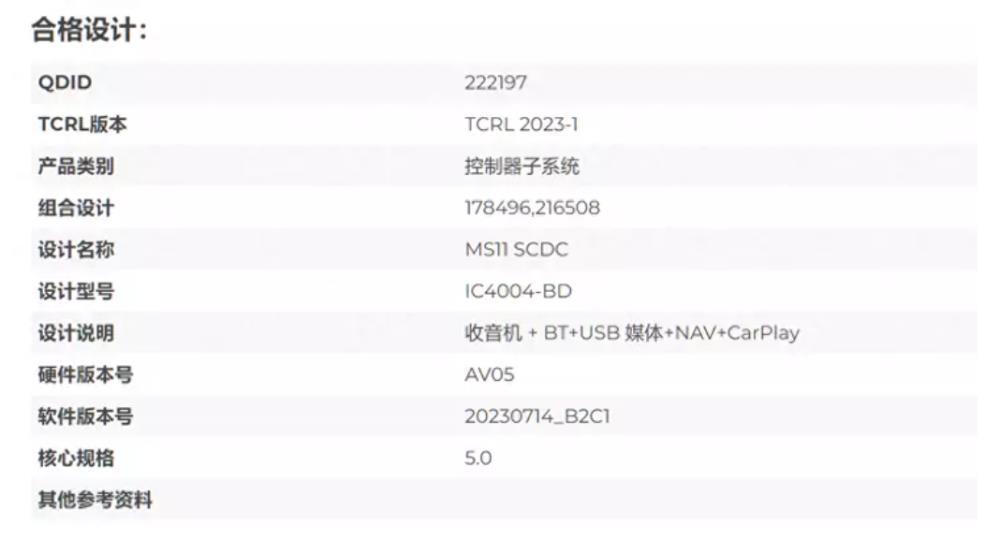
11. On September 27th and 28th, Xiaomi established Jingming Technology Company in Shenzhen, Wuhan, including automobile sales service.
Tianyancha App shows that Wuhan Xiaomi Jingming Technology Co., Ltd. and Shenzhen Xiaomi Jingming Technology Co., Ltd. were established. The legal representatives are Lei Yun and Li Xiaoshuang respectively, with a registered capital of 10 million yuan. Their business scope includes electronic product sales, automobile sales, new energy vehicle sales, used car brokerage, and minibus rental and operation services. The panorama of equity shows that both companies are wholly-owned by Xiaomi Jingming Technology Co., Ltd., which is a wholly-owned subsidiary of Xiaomi Intelligent Technology Co., Ltd.
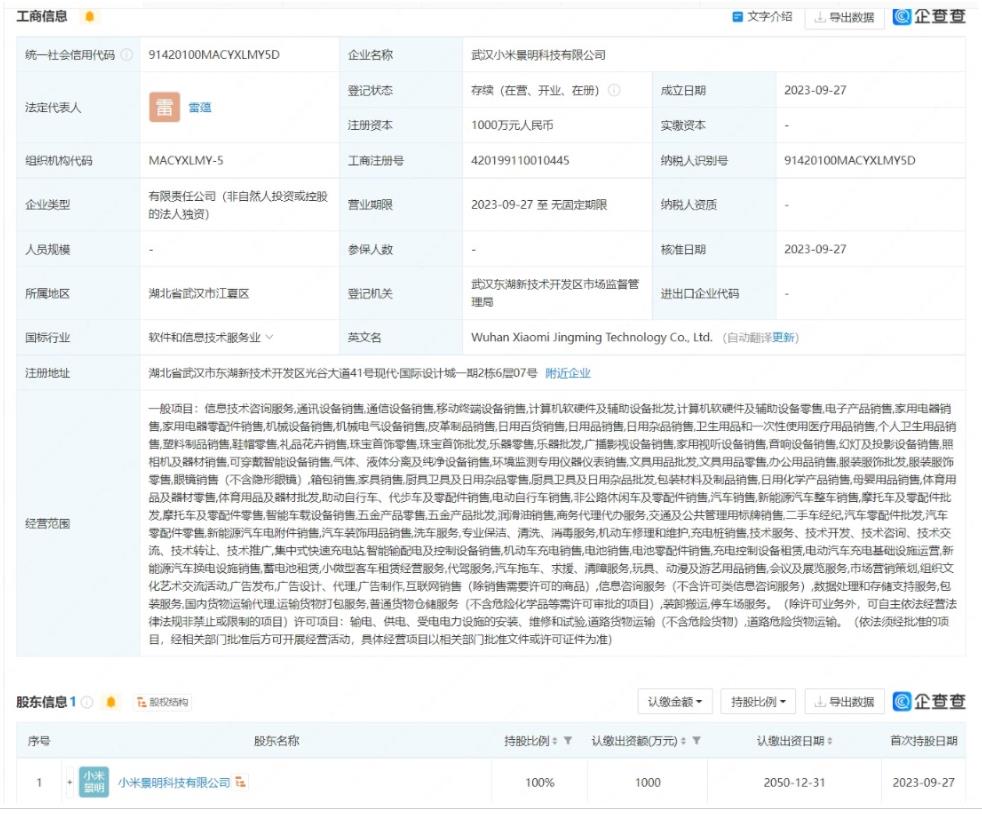
12. On September 25th, gossip: Xiaomi Automobile may show up in October.
A digital circle blogger posted a dynamic on the social platform, which read: Gossip: Xiaomi Auto may show up in October.
The press conference of Xiaomi 14 is expected to be held in October. If the rumor is true, Lei Jun will report the progress of Xiaomi Automobile at the press conference.
XIII. On September 19th, the wireless charging patent of Xiaomi Automobile was authorized.
Tianyancha App shows that on September 19th, the patent of "wireless charging method, system and storage medium" applied by Xiaomi Automobile Technology Co., Ltd. was authorized.
The summary shows that the disclosed charging device determines the target parking space where the vehicle is currently parked under the condition of receiving the charging request message sent by the vehicle to be charged; Determining a target induction coil corresponding to the target parking space from the coil array; Positioning an electric energy receiving coil arranged on a vehicle through a target induction coil to obtain the target position of the electric energy receiving coil; Take any idle electric energy transmitting coil located in a preset place as the target electric energy transmitting coil, and move the target electric energy transmitting coil to the target position, so as to wirelessly charge the vehicle through the target electric energy transmitting coil and the electric energy receiving coil.
This patent avoids the driver’s need to constantly adjust the parking position of the vehicle to realize the accurate alignment between the target electric energy transmitting coil and the electric energy receiving coil, thus reducing the complexity of the driver’s parking operation and improving the parking freedom of the vehicle.
14. On September 18th, a new patent for Xiaomi Automobile was announced: it can wake up the vehicle in advance according to the habit of using the car and reduce the response time.
On September 18th, according to the announcement on the website of China National Intellectual Property Administration, the patent of "vehicle wake-up method, device, storage medium and vehicle" of Xiaomi Automobile Technology Co., Ltd. was announced on September 12th.
The disclosure relates to a vehicle wake-up method, a device, a storage medium and a vehicle, and relates to the technical field of vehicles. The method comprises the following steps: acquiring a record of a user using a vehicle; According to the record, the user’s car time period is determined from the time period; Wake up the vehicle before it reaches the car time period of the current time period. When the end user uses the vehicle, the vehicle is already awake, which can quickly respond to the user’s operation, improve the user’s car experience, and solve the problem of slow vehicle response in related scenes. Because the vehicle is woken up before the car use period, it can reduce the energy consumption of the vehicle compared with the way of waking up the vehicle all the time.
The patent of Xiaomi Automobile points out in the background that the current user can remotely control the vehicle to perform operations such as turning on the air conditioner and unlocking the lock through the mobile phone, but the response time of the vehicle to the user’s operation request is still long in some scenes, which reduces the user’s experience.
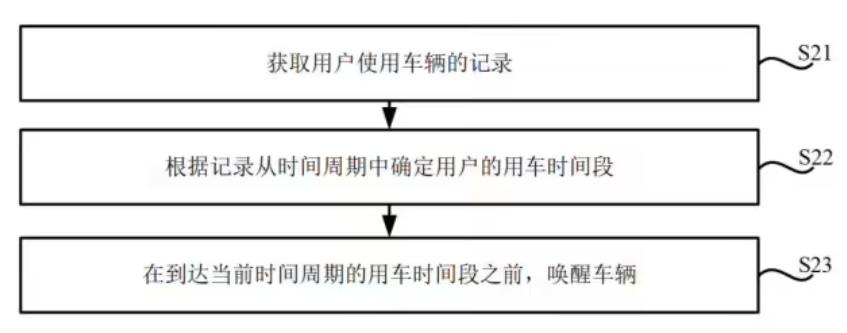
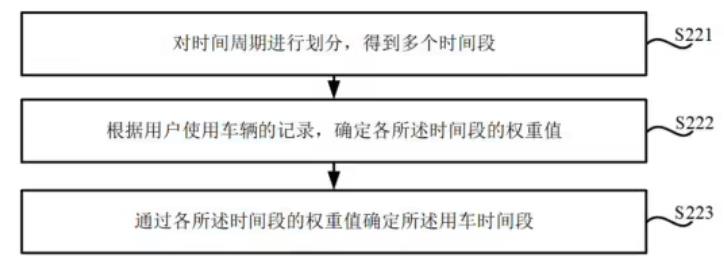
15. On September 12th, it was reported that the Tongzhou production base of Xiaomi Automobile entered the sprint stage of production debugging.
According to shanghai securities news news, the Tongzhou production base of Xiaomi Automobile has entered the sprint stage of production debugging. Lei Jun, the chairman of Mi Group, has recently led Xiaomi Auto executives to complete the road test of new cars in Xinjiang in the summer, in order to enter the mass production of new cars as soon as possible after obtaining relevant approvals.
It is reported that the whole base includes six workshops, including die casting, stamping, car body, painting, assembly and battery. In the die-casting workshop, the sign of "Xiaomi Super Die-casting" has been hung up, which means that Xiaomi Automobile may adopt advanced integrated die-casting technology similar to that in Tesla Giga Shanghai.
?
XVI. On September 11th, the spy photos of Xiaomi’s trunk were exposed, and the comments of netizens resembled Buds4 Pro charging box.
Recently, a spy photo of the trunk of Xiaomi car was circulated on the Internet, which triggered a heated discussion among netizens. This photo shows that after the trunk of Xiaomi car is opened, its shape is similar to that of Xiaomi Buds 4 Pro earphone box, and it also has the shadow of a large USB-C charging port. This unique design is impressive.

Seventeen, Xiaomi new car spy photos
It is reported that Xiaomi’s new car is a slip-back design, with laser radar on the top of the head (presumably with high-order intelligent driving), the chassis is very low, which is similar to the traditional sports car, and the body size may reach B+ level. The top of the car is a giant integrated canopy, equipped with hidden door handles and penetrating taillights. The tail on the tailgate is also obvious. The wheels with double five shapes are adopted, and the new Logo of Xiaomi is printed in the center of the wheel hub. Low-lying hunting and running style+larger size space may be the difference between Xiaomi car and similar competing products.
In addition, another spy photo shows that Xiaomi will adopt the design of frameless doors.
The interior style has also been simplified. The center console is equipped with a large-size central control panel in the middle. From the test car in the picture, the whole front is still a small-size LCD instrument with a flat-bottomed steering wheel. However, it is temporarily uncertain whether Xiaomi will add more screens in the back row.


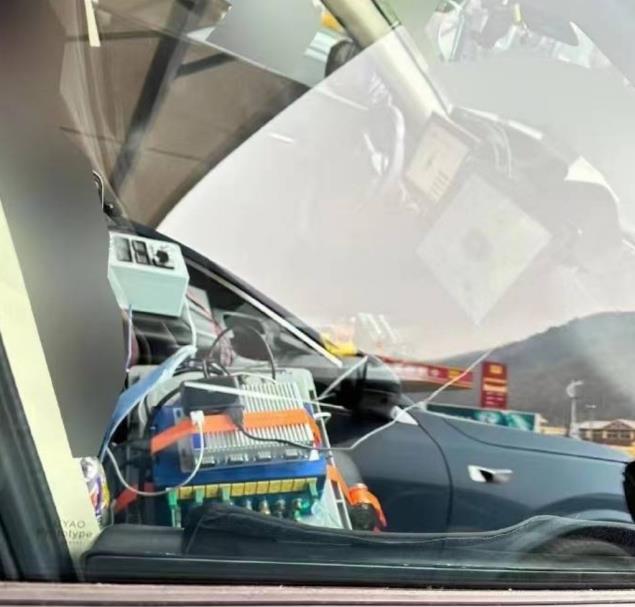
18. On September 6th, Xiaomi Automobile has been in trial production for nearly a month, with 50 prototype cars per week, and another 100 workers have been recruited to prepare for mass production.
Xiaomi Automobile is now in the trial production stage. This work has been carried out for less than a month, and it is conducting a comprehensive test on production line equipment, process connection and worker proficiency. At present, Xiaomi produces about 50 prototype cars every week, and there are few workers at night. A person familiar with the matter said, "The approval of Xiaomi Automobile from the Ministry of Industry and Information Technology is expected to be approved in the last two months and before the end of the year at the latest, and then mass production can begin."
At present, the Yizhuang factory of Xiaomi Automobile is recruiting workshop workers on a large scale, with a gap of 100 workers in five major types of operation, opening up a number of positions such as painting operators and battery workshop operators, with an average salary of 6,000 to 7,000 yuan, and a daily working time of 8 hours. You can join at any time on weekends.
?
On September 2nd, 19th, it was reported that the first car of Xiaomi would use the laser radar of Hesai.
On September 2 nd, according to "Late Auto", the specific lidar configuration of Xiaomi’s first model is based on a hybrid solid-state radar AT128 and several all-solid-state radars as blind-compensating radars.
?
20. On August 29th, Xiaomi Q2 released its financial report, and invested 1.4 billion yuan in car innovation.
On August 29th, Lei Jun, founder, chairman and CEO of Xiaomi Group, reported the Q2 financial report of Xiaomi in 2023 in Weibo. The R&D expenditure of Xiaomi Group in the second quarter was 4.6 billion yuan, up by 21%, including 1.4 billion yuan invested in innovative businesses such as smart electric vehicles, and announced that it would achieve the carbon neutrality goal of existing businesses in 2040.
In the conference call after the release of Xiaomi’s financial report, Lu Weibing, president of Xiaomi, mentioned in an interview that the actual investment of Xiaomi Automobile is even greater. Xiaomi is making the long-term layout of the automobile with the goal of entering the top five in the world in the future, doing self-research in the whole stack and building its own automobile factory, so the investment in cash flow is even higher than the disclosed figures. In addition, he also said that Xiaomi Automobile has just finished the summer test, and the progress has exceeded expectations, maintaining the mass production target in the first half of 2024 unchanged.
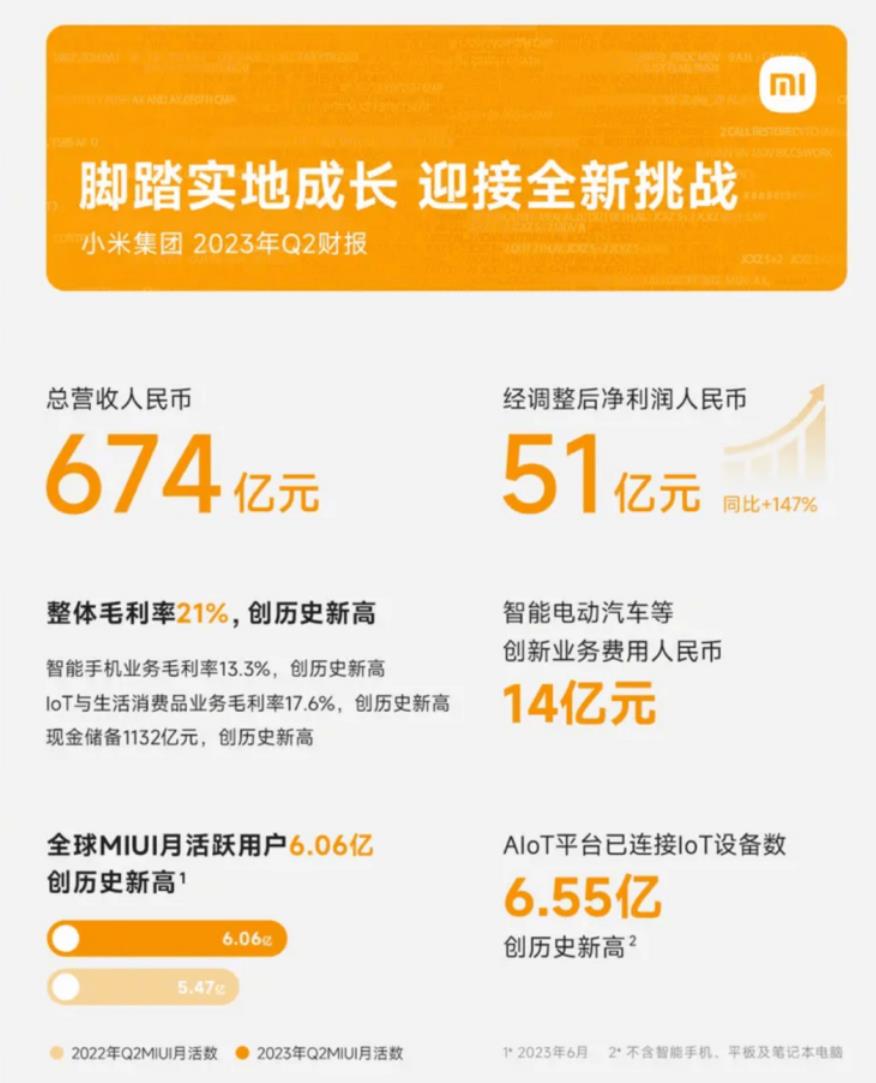
21. On August 28th, the LOGO on the welcome pedal of Xiaomi Automobile was exposed.

22. On August 25th, Xiangxin Technology: The company established a cooperative relationship with Xiaomi Automobile.
Xiangxin Technology said on the investor interaction platform on August 25 that the company has established a cooperative relationship with Xiaomi Automobile. The company’s main business includes automobile molds, automobile body structural parts, power battery boxes and other products. The company has advanced mold development technology in automobile lightweight forming (such as ultra-high strength steel plate and aluminum-magnesium alloy cold stamping technology), which can provide lightweight overall solutions for customers in the new energy automobile industry.
?
On August 23rd, it was reported that the National Development and Reform Commission had approved Xiaomi to produce electric vehicles.
According to Reuters, Xiaomi Automobile has been approved by the National Development and Reform Commission to produce electric vehicles. If the news is true, then Xiaomi will be the fourth batch of enterprises approved by the National Development and Reform Commission since the end of 2017. This also means that Xiaomi Automobile has always emphasized that mass production and listing in 2024 already have basic conditions.
?
24. On August 23rd, the domain name of Xiaomi Auto’s filing website was "xiaomiev.com".
Tianyancha App shows that Xiaomi Automobile Technology Co., Ltd. recently registered the domain name of xiaomiev.com website.
The company was established in November 2021, and its legal representative is Lei Jun with a registered capital of RMB 1 billion. Its business scope includes technology development, vehicle manufacturing of new energy vehicles, technology research and development of vehicles and parts, road motor vehicle production, etc. Xiaomi Technology Co., Ltd. is wholly-owned by Xiaomi Technology Co., Ltd.
?
25. On August 22nd, the battery suppliers of Xiaomi Automobile have been finalized. The first supplier and the second supplier are Zhongchuang Singapore Airlines and Contemporary Amperex Technology Co., Limited respectively.
According to the interface news, it was learned from insiders of Xiaomi that this year, Xiaomi Automobile has finalized Zhongchuang Singapore Airlines (formerly known as AVIC Lithium Battery) and Contemporary Amperex Technology Co., Limited as the primary and secondary battery suppliers at this stage.
Before Singapore Airlines did not win the lawsuit against Contemporary Amperex Technology Co., Limited, Xiaomi’s tentative first-tier supplier was Contemporary Amperex Technology Co., Limited. Because the output of Xiaomi Automobile still needs to climb in the initial stage, the bargaining power of Xiaomi Automobile is not high. The cost of purchasing a battery pack starts at 80,000 yuan, and the battery cost accounts for about 50% of the total vehicle cost. In order to further reduce the cost, Xiaomi Automobile has made adjustments in the near future.
As for the battery suppliers of Xiaomi Automobile, it was generally speculated that they were Contemporary Amperex Technology Co., Limited and BYD, and BYD related people also revealed to the interface news that there is no Xiaomi Automobile in its power battery supply list at present.
Insiders of Xiaomi said that Xiaomi Automobile has clearly defined the strategy of making money without hardware and software. In order to keep the advantage of high cost performance of Xiaomi, the profit rate of parts of Xiaomi Automobile will remain at around 1%, and the future profit mainly depends on software services and ecological services.
?
26. On August 19, Lei Jun and Lu Weibing appeared in Xinjiang. The road test of Xiaomi Automobile has been officially announced, and the battery life was first exposed: 100 kilometers need 8.8 kWh.
On August 18, some netizens exposed four Xiaomi cars that happened to be closely disguised on the Urumqi-Changji urban expressway and galloped on the expressway. At the same time, the Weibo IP addresses of Lei Jun, founder, chairman and CEO of Xiaomi, and Lu Weibing, president of Xiaomi Group, are all displayed in Xinjiang. The banner in the picture shows the words "Fight for Xiaomi Automobile".
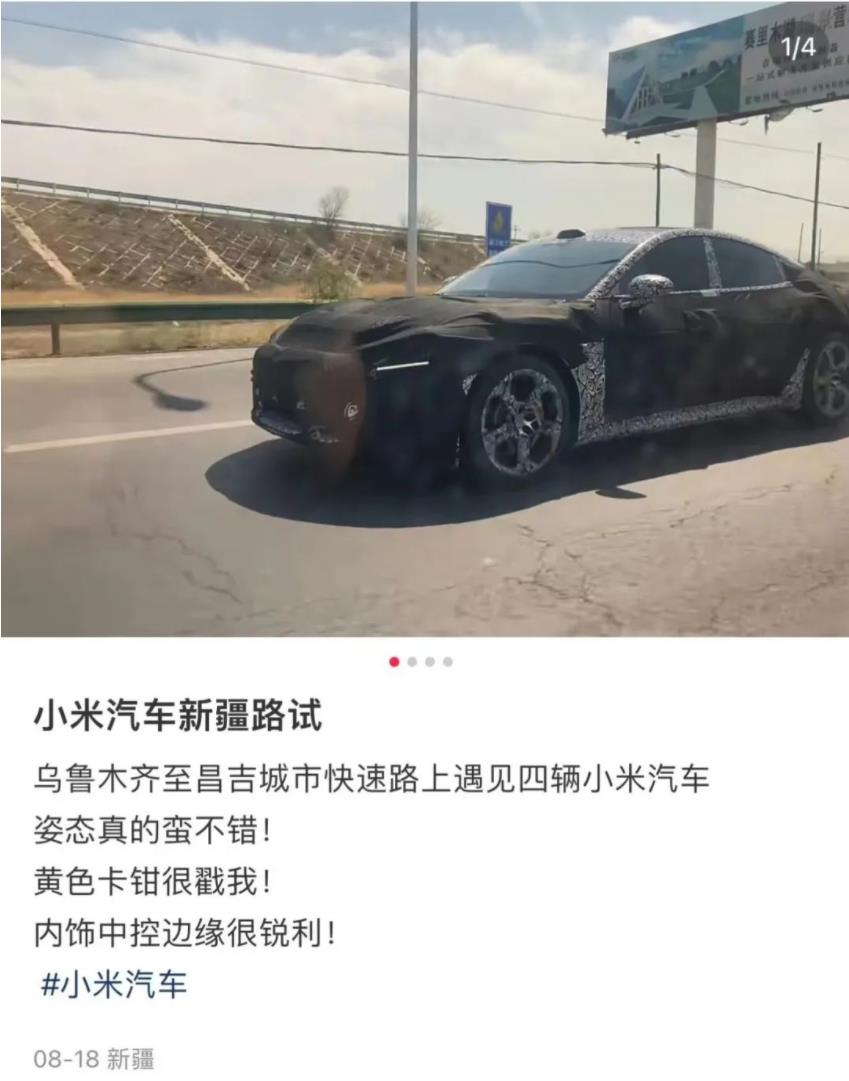

In addition, Hu Zhengnan, a co-investor of Shunwei Capital, also released a Weibo, saying that his test vehicle had tested the power consumption of 8.8kwh per 100 kilometers. As the former president of Geely Automobile Research Institute, Hu Zhengnan, although he is the first-ranked capital, shows that he is serving Xiaomi Automobile by the relationship between the first-ranked capital and Xiaomi. This Weibo also proves once again that Xiaomi has some new information, and the power consumption control level of the new car is not bad.
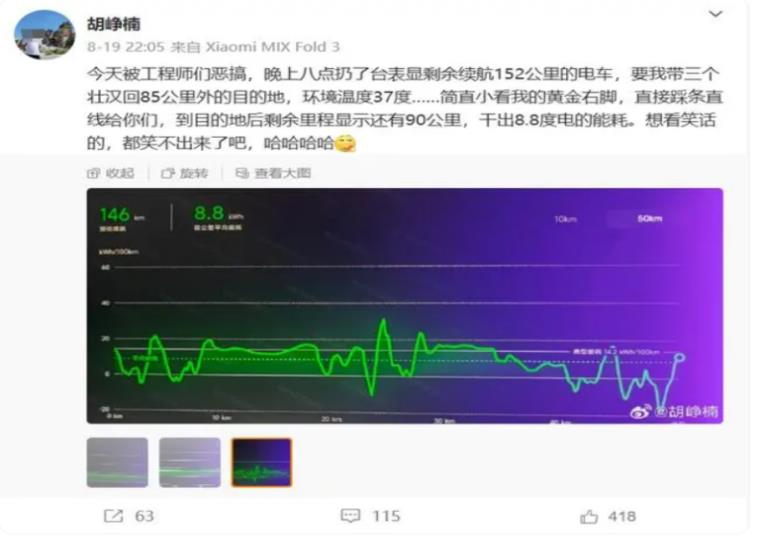
27. On August 19th, Xiaomi released the financial report for the second quarter of 2022 and the performance announcement for the first half of the year.
On the evening of August 19th, Xiaomi Group released the results announcement for the second quarter and the first half of 2022. In the second quarter, the company’s revenue was 70.2 billion yuan, down 20% year-on-year. R&D expenditure reached RMB 3.8 billion, and accumulated R&D investment in the first half of the year was RMB 7.3 billion. Among them, the first phase of research and development of autonomous driving invested 3.3 billion.
28. On August 17th, Xiaomi automobile battery suppliers locked in Contemporary Amperex Technology Co., Limited and BYD, focusing on power.
According to industry sources, two main suppliers of power batteries for Xiaomi electric vehicles have been identified, namely, Foday batteries owned by Contemporary Amperex Technology Co., Limited and BYD. In the future, Xiaomi cars will be equipped with Kirin batteries and BYD blade batteries from Contemporary Amperex Technology Co., Limited.
It is understood that the first model of Xiaomi Automobile has two configurations, high and low. The low-profile model plans to adopt a 400V voltage platform and a Ferrous lithium phosphate blade battery equipped with Foday battery; The high-profile models are planned to adopt 800V voltage platform, equipped with the latest ternary Kirin battery from Contemporary Amperex Technology Co., Limited.
The extended-range version is expected to be equipped with a 1.5L or 1.5T range extender and a large-capacity battery.
?
29. On August 14th, Lei Jun said in his annual speech: In the next five years, Xiaomi’s R&D investment will exceed 100 billion yuan.
On the evening of August 14th, at the launch of Xiaomi’s new products, Lei Jun officially announced the strategic upgrade of Xiaomi’s science and technology. He said that Xiaomi will continue to choose technical fields with long-term value for human civilization, and will invest 100 billion yuan in technology in the next five years.
?
30. On July 24th, a new patent of Xiaomi Automobile was issued: the screen of the car can be translated left and right to meet the use needs of passengers after lying down.
According to China National Intellectual Property Administration official website, the patent for "display assembly and vehicle" applied by Xiaomi Automobile was authorized and announced on July 18th, 2023.
It shows that this patent designs a vehicle display screen assembly, which includes display screen, translation mechanism and first rotation mechanism. Among them, the translation mechanism can drive the first rotation mechanism to translate, and the first rotation mechanism can drive the display screen to "rotate around the rotation axis extending in the horizontal direction", thus realizing the "nodding up and down" of the display screen.
The display screen assembly claims to be "able to realize the translation of the display screen and meet the use requirements of the passengers after lying down".
It is worth noting that there are already similar models on the market at present-extremely krypton X. The central control panel of this car can slide from the central position of the center console to the position right in front of the co-pilot through the electric mechanism, which is particularly different in the current trend that more and more new cars are equipped with the central control panel and the co-pilot screen at the same time.
31. On July 16th, the information of Xiaomi automobile battery was exposed.
The nameplate of a suspected Xiaomi car shows that its battery pack parameters have a rated voltage of 726.7V, a rated capacity of 139Ah, a battery pack capacity of 101kWh and a weight of 642kg, and the converted energy density is 157Wh/Kg. Based on this, it is inferred that the first model of Xiaomi is likely to support 800V high-voltage fast charging, the cruising range is expected to be more than 700 kilometers, and the price is expected to be around 300,000 yuan.

32. On July 6th, Xiaomi Automobile began to screen delivery centers.
On July 6, some netizens said that according to the feedback from the dealer group, Xiaomi Automobile has started the screening of the delivery center, requiring the candidate venues to provide at least 120 parking spaces with a construction area of not less than 3,000 square meters.
In addition, he also said that Xiaomi Automobile "has a lot of people from the world", and it is expected to adopt the common operation mode in the industry in the future: Xiaomi mobile phone franchise store+delivery center+authorized body painting center.
In addition, the factory construction of Xiaomi Automobile has also made new progress. According to the plan, Xiaomi Automobile Factory will be built in two phases. The first phase covers an area of nearly 720,000 square meters. It will be started in April 2022 and completed in June 2023. The second phase is planned to start in 2024 and be completed in 2025. Among them, the first phase includes four factories with an annual production capacity of 150,000 vehicles. At present, the first phase factory of Xiaomi Automobile was completed and accepted last month according to the established plan.
33. On July 5th, the first model of Xiaomi has been quoted.
Recently, on the E-interactive platform of SSE, FAW Fuwei said in response to a netizen’s question about "cooperation with Xiaomi Automobile" that the company is actively communicating with Xiaomi Automobile, and many molecular companies have entered the purchasing group of Xiaomi Automobile. At present, the first model of Xiaomi has been quoted.
34. On June 2nd, it was reported that a number of senior positions of Xiaomi Automobile were adjusted, and Huang Zhenyu, a former Magna executive, took over the supply chain.
Xiaomi Auto recently announced a number of high-level job adjustments, with former Magna executive Huang Zhenyu taking over the supply chain.
According to the report, Huang Zhenyu, vice president of Xiaomi Automobile Department, is also the general manager of Supply Chain Department of Automobile Department, reporting to Lei Jun, CEO of Automobile Department. Previously, Xiaomi Automobile Supply Chain was under the responsibility of Xiaomi veteran Li Xiaoshuang. Huang Zhenyu was the vice president of Magna China, a global supplier of automobiles.
In addition, it is reported that Li Xiaoshuang’s work focus will shift to the market business, and he will concurrently serve as the general manager of the marketing department of the automobile department, reporting to Lei Jun, CEO of the automobile department; Qin Zhifan is the deputy general manager of the marketing department of the automobile department and reports to Li Xiaoshuang. Both of them are early employees of Xiaomi, and both of them are in the 17-person core team of Xiaomi Automobile.
?
35. On May 24th, Xiaomi Q1 reported that it invested 1.1 billion yuan in automobile business.
Lei Jun, founder, chairman and CEO of Xiaomi Group, released Xiaomi Q1 financial report on social media and revealed the news related to automobiles. Xiaomi Group’s R&D expenditure in the first quarter was 4.1 billion yuan, up by 17.7%, of which 1.1 billion yuan was invested in innovative businesses such as smart electric vehicles. In addition, Xiaomi Group predicts that the total R&D investment will exceed 20 billion yuan in 2023. Lei Jun said that the new business strategy of "paying equal attention to scale and profit" has achieved results.
On the conference call of Xiaomi Financial Report, Lu Weibing, president of Xiaomi, said, "The car-making business will be carried out according to the original plan, and the time schedule will meet or slightly exceed expectations. This year, Xiaomi Automobile will also conduct winter and summer tests as planned. "
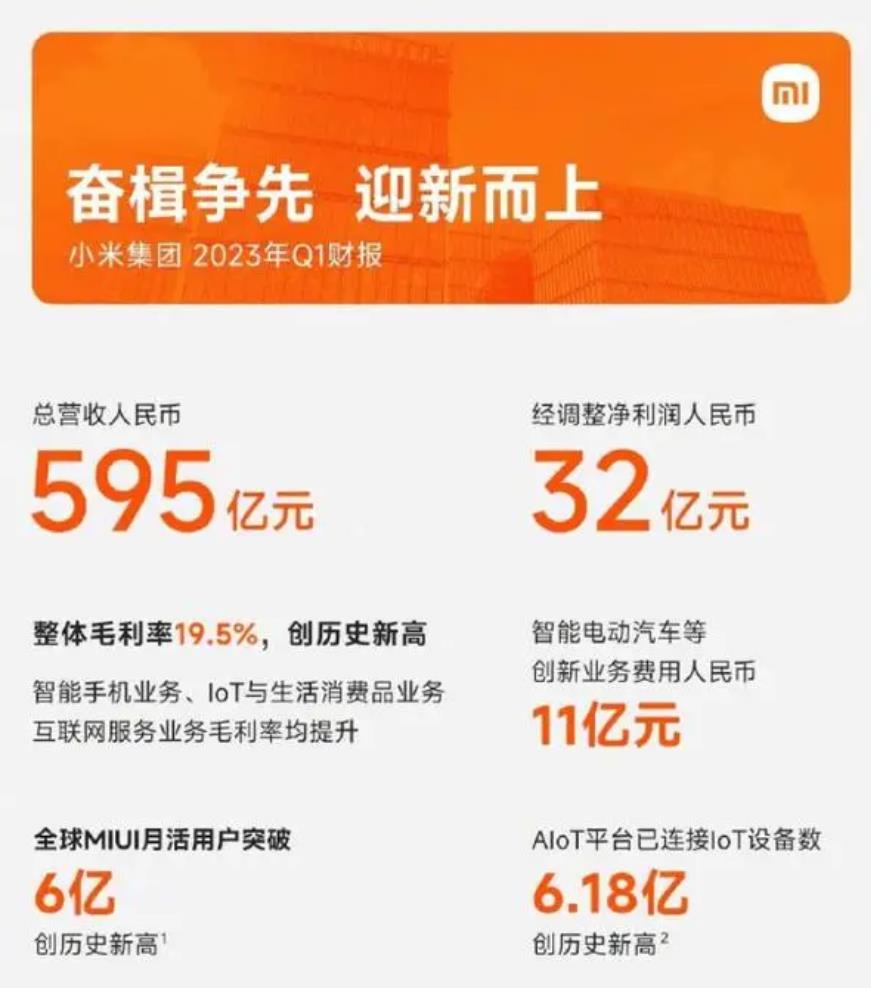
36. On February 3rd, Xiaomi’s digital key patent was announced, which can improve the battery life of the equipment.
Tianyancha App shows that on February 3rd, the patent of "Control Method, System, Device and Digital Key Equipment" applied by Xiaomi Automobile Technology Co., Ltd. was announced.
The patent abstract shows that the digital key device can calculate the distance between itself and the target vehicle according to the locked position of the target vehicle and its real-time position at the current moment, and obtain the inertial navigation data collected by the inertial navigation device when the distance is less than the first threshold, and then identify the behavior of the user carrying the digital key device at the current moment according to the inertial navigation data, and control the Bluetooth module of the digital key device to work in the monitoring mode when the behavior indicates that the user is in a moving state, so as to establish a Bluetooth connection with the target vehicle. The technical scheme can reduce the power consumption of digital key equipment and improve its endurance.
?
Thirty-seven, January 31, Xiaomi Automobile has a new patent: it can control vehicles through wearable devices.
Enterprise search App shows that Xiaomi Automobile Technology Co., Ltd. has published a number of patents, including "wearable devices and data processing methods for wearable devices" and "control methods, devices, electronic devices and storage media for vehicles".
Specifically, the patent abstract of "wearable device and data processing method of wearable device" shows that the wearable device includes a display screen, a first Bluetooth module and a processor. Wherein, the first Bluetooth module is used for establishing communication connection between the wearable device and the vehicle; The processor is used for acquiring the distance between the wearable device and the vehicle, and automatically switching the interface of the display screen when the distance is less than a set distance threshold to control one or more controls of the vehicle.
38. On January 28th, the design renderings of the suspected Xiaomi car MS11 were exposed.
A few days ago, a group of appearance renderings of MS11, the first model of Xiaomi Automobile, were uploaded on the Internet. The overall outline was basically consistent with the previously exposed local design drawings and road test spy photos. It is understood that the new car is suspected to be a screenshot of the internal review video, which may not be the final version.
Judging from the design, Xiaomi’s first model code MS11 is a car similar to Tesla Model 3.
In terms of appearance, from the perspective of exposure renderings, the appearance of Xiaomi MS11 is highly original. The closed front grille with rounded headlights has the visual effect of high-end sports cars, and the silver chrome trim around the front is full of personality. There is also a laser radar at the top of the windshield.
The side of the car body adopts a smooth slip-back design, and the hidden door handle and petal-shaped wheels create a sense of fashion. The roof is a whole panoramic canopy, and the shape of the tail is very layered. It is expected that the popular through-light group will be adopted.



39. On January 24th, Xiaomi Automobile was exposed to the front and rear design drawings, and the official response was not the final document.
Recently, a group of design pictures of the first model of Xiaomi automobile circulated on the Internet, mainly showing the design details of the front face and tail of the vehicle, including the bumper of Xiaomi automobile, the decorative parts of Xiaomi MS11, and the cooperation details of Xiaomi and BAIC molding.
In response, Wang Hua, general manager of Xiaomi Group’s public relations department, responded that it was indeed the confidential design documents of secondary suppliers that leaked; The supplier is only a supplier of mold proofing, and the leaked document is the design draft of the very early bidding process, not the final document; (Xiaomi) will definitely deal with it seriously according to the confidentiality agreement signed with the supplier.
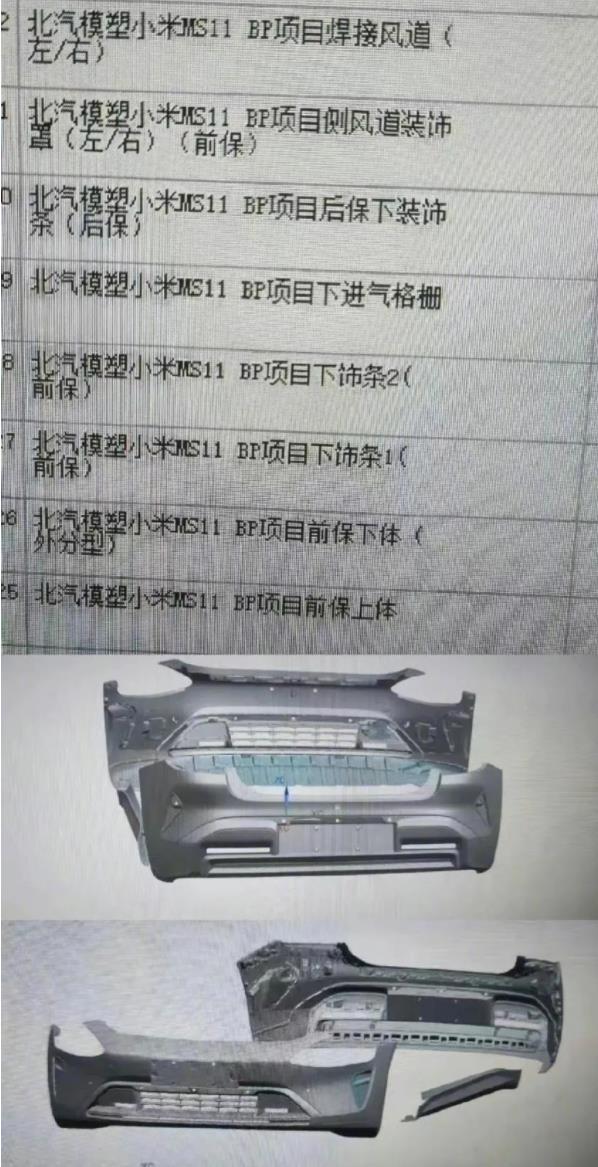
40. On January 17th, the first model entered the winter test stage, and the next step was mass production planning.
On January 17, two spy photos of suspected Xiaomi car were circulated on the Internet, saying that Lei Jun personally tested Xiaomi car. From the picture, Lei Jun is driving a camouflage test vehicle with a slip-back shape, and the outline of the whole vehicle is almost the same as that of a heavy camouflage vehicle suspected of Xiaomi car in Xiaomi Science and Technology Park.
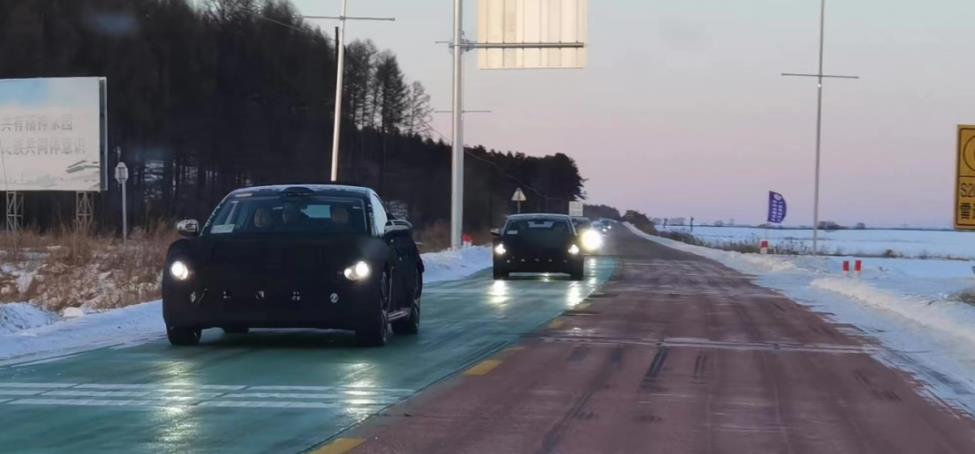
Forty-one, January 14th, the original
Yu Liguo, President of Extreme Fox Automobile, joined Xiaomi Automobile as Vice President.
Today, Xiaomi announced the appointment of Yu Liguo as the vice president of Xiaomi Automobile and the political commissar of Xiaomi Automobile Beijing Headquarters. He is mainly responsible for coordinating the comprehensive management of Xiaomi Automobile, the promotion of special business, the organization and talent construction of Xiaomi Automobile Beijing Headquarters, and reporting directly to Xiaomi Automobile CEO Lei Jun.
?
Forty-two, January 6, according to media reports, Xiaomi tentatively decided that the first model was a medium-sized slip-back sedan with internal code name Modena Modena.
According to the late latepost news, Xiaomi’s first car is a medium-sized hatchback (internal code name Modena Modena), which is divided into two versions, one version is priced at 260,000-300,000 yuan, and the other version is more than 350,000 yuan.
The two versions of Xiaomi car are different in three electric systems and intelligent driving.
ONE of them is based on the mainstream 400V platform, equipped with BYD lithium iron phosphate battery. For intelligent driving, 5R1V (five millimeter wave radars and one camera) multi-sensor fusion scheme provided by the supplier mainland is adopted, which is consistent with the technical route of 2021 Li ONE.
The high-priced version is based on 800V high-voltage platform and equipped with Contemporary Amperex Technology Co., Limited’s Kirin battery, which is expected to achieve 80% charging in 15 minutes. Intelligent driving is equipped with NVIDIA Orin X chip and laser radar, and the algorithm is developed by Xiaomi.
Both versions of the car engine system adopt Qualcomm’s next generation intelligent cockpit chip (8295 chip). The chip has not yet been mass-produced, and it is expected to be carried on Jidu ROBO-01 for the first time in the second half of this year.
According to people close to Xiaomi, Xiaomi is still developing the second production car, which is planned to be launched in 2025. This car is on the same platform as Modena, but the electric drive system is three motors, and the electronic control software is developed by Xiaomi.
News in 2022
?43. On September 29th, Lei Jun revealed the progress of Xiaomi Automobile: the first engineering vehicle has officially rolled off the assembly line.
According to The Paper, in a recent internal speech, Xiaomi founder Lei Jun revealed that Xiaomi’s first engineering vehicle has officially rolled off the assembly line.
?
44. On August 11, Xiaomi’s autumn new product launch conference disclosed the latest progress of autonomous driving technology for the first time.
This Xiaomi conference revealed for the first time the progress made by Xiaomi since it was announced 500 days ago. Lei Jun said that Xiaomi invested 3.3 billion yuan in research and development expenses in the first phase of autonomous driving, and organized a research and development team of more than 500 people. The collaborative team includes Xiaomi Xiaoai, artificial intelligence lab and members of the mobile phone camera department. It is expected that by the end of this year, the team size will exceed 600.
In the field of autonomous driving, Xiaomi adopts the technical layout strategy of self-developed station algorithm. The fields of technicians cover sensors, chips, sensing orbit control algorithms, simulation technology, high-precision maps, tool chains, training capabilities and other fields.
At the press conference, Xiaomi also released a real video of the road test of autonomous driving technology. Starting with the one-button call for vehicles, the automatic navigation function is turned on, which shows the functions of automatically entering the ramp, actively changing lanes to overtake, automatically turning around in unprotected scenes, automatically turning right in unprotected scenes, automatically bypassing the temporarily stopped vehicles, automatically bypassing the accident vehicles, automatically bypassing around the island, allowing pedestrians at zebra crossing, autonomous parking service, automatically descending the continuous ramp, automatically passing through a 90-degree sharp bend, automatically avoiding pedestrians, automatically bypassing piles and barrels, and automatically charging.
Although the display vehicle is a test vehicle modified by other brands, the laser radar on the roof, the cameras on the front wings on both sides, and the cameras in front and behind all reflect the application of Xiaomi’s automatic driving scheme to related sensors. With the further maturity of technology, the sensing scheme of Xiaomi automobile will probably surface further.
In addition, Xiaomi’s autopilot team also announced the launch of an integrated intelligent parking solution, covering many functions such as "parking reservation", "autonomous parking service" and "automatic charging of mechanical arm", and other parking services will be opened in the future.
Lei Jun said that the first phase of Xiaomi’s autonomous driving technology plans 140 test vehicles, which will be tested in the country one after another, with the goal of entering the first camp in the industry in 2024.
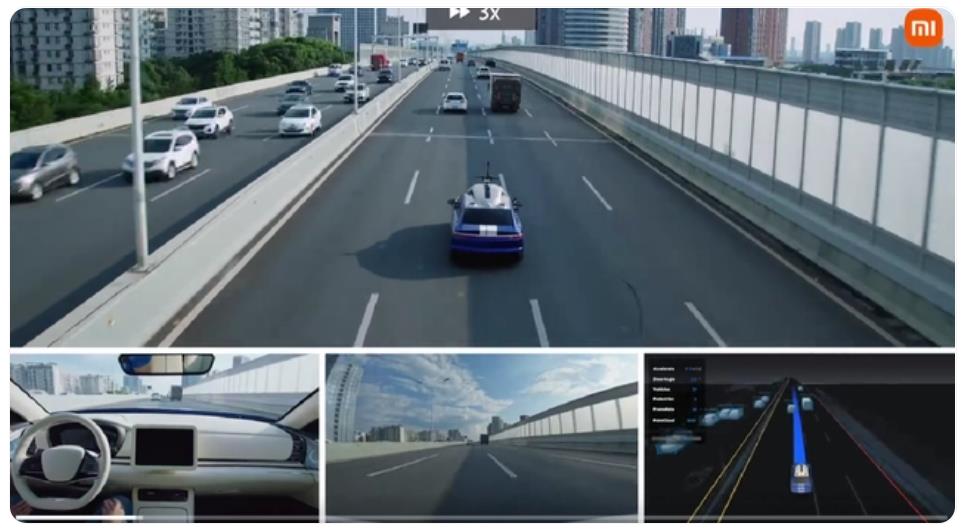
45. On August 10th, Xiaomi became a shareholder in Dingsheng Microelectronics, an automobile resistance manufacturer.
?
46. On May 13th, Xiaomi invested in the commercial law of lithium-ion battery materials Enlet.
?
47. On March 7th, Xiaomi took a stake in Kangzhi Integration, a smart car chip company, and laid out a video transmission chip.
?On March 7 th, the enterprise search App showed that Xiaomi recently shot again and became a shareholder in Kangzhi Integrated Circuit (Shanghai) Co., Ltd. Founded in 2017, the company’s business scope includes R&D and design of integrated circuits and chips, and technical development in the field of electronic technology. According to official website, it focuses on the field of smart cars.
?
48. On February 10th, Zhilu Technology, a supplier of electrical systems for new energy vehicles, announced the completion of a new round of financing, which was also led by Xiaomi.
?
Forty-nine, February 25th, intelligent lidar system technology enterprises.
Sagitar Juchuang won over 2.4 billion financing, and Xiaomi led the investment.
News in 2021
50. On November 27th, Xiaomi Automobile Headquarters settled in Beijing.
On November 27th, the official WeChat of Beijing Yizhuang released a message that the signing ceremony between the Management Committee of Beijing Economic and Technological Development Zone and Xiaomi Technology was held. With the signing of the Cooperation Agreement, Xiaomi Automobile was officially announced to settle in Beijing Economic Development Zone.
Xiaomi Automobile Project will build Xiaomi Automobile Headquarters Base, Sales Headquarters and R&D Headquarters, and will build a vehicle factory with an annual output of 300,000 vehicles in two phases, of which the first and second phases will have a production capacity of 150,000 vehicles respectively. It is expected that the first vehicle will be rolled off the assembly line in 2024 and mass production will be realized.
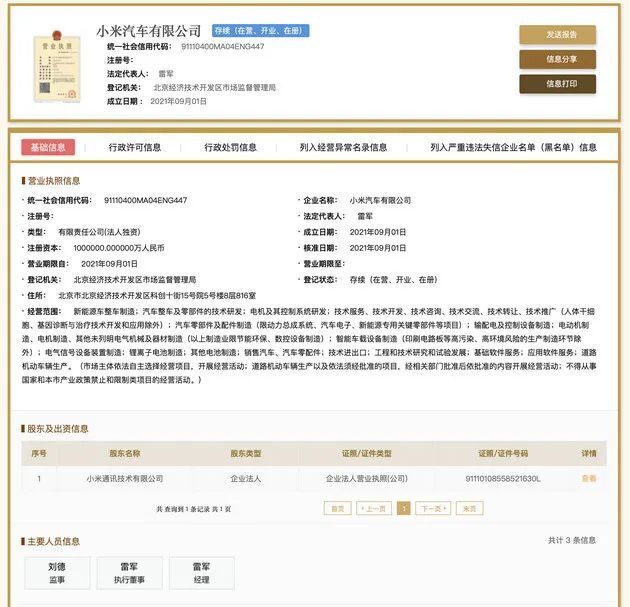
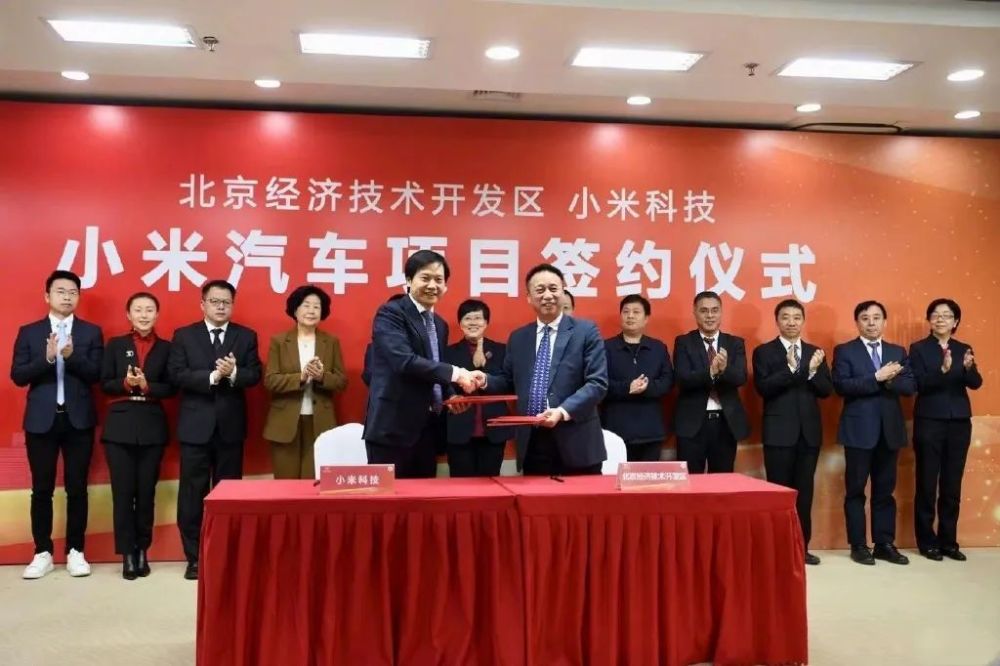
51. On October 19th, Lei Jun: Xiaomi Automobile is expected to be mass-produced in the first half of 2024.
At the investor conference held by Xiaomi, Lei Jun said at the meeting that Xiaomi Automobile is expected to be mass-produced in the first half of 2024, and the progress of Xiaomi’s car-making and team work far exceeds expectations.
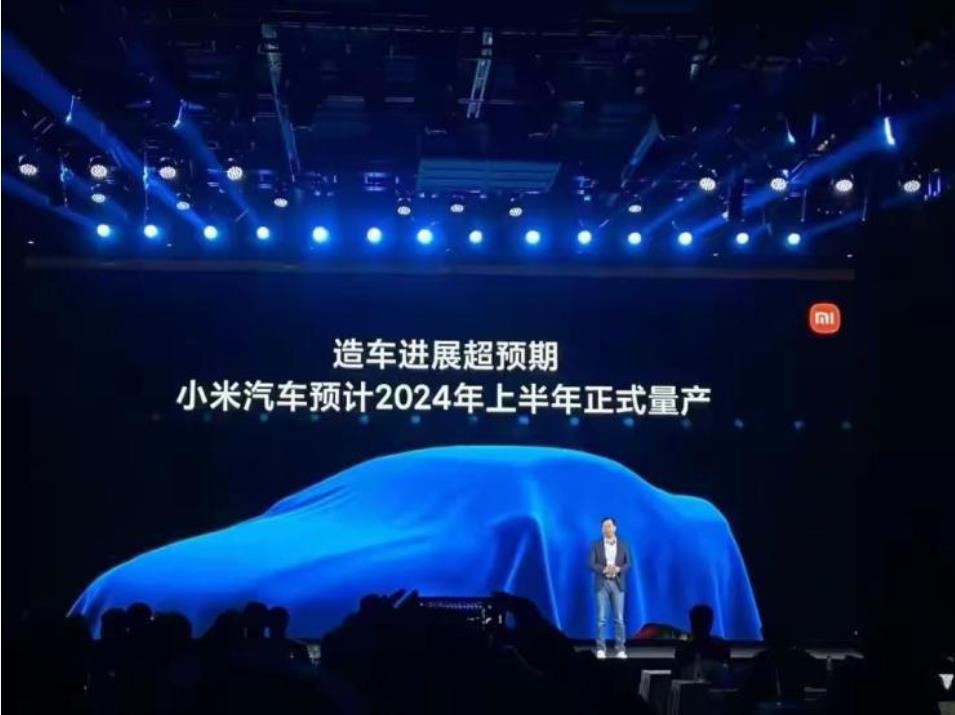
52. On September 1st, Xiaomi Automobile officially completed industrial and commercial registration, and Xiaomi Automobile Co., Ltd. was established.
On September 1st, Xiaomi Technology Co., Ltd. announced that Xiaomi Automobile has officially completed the industrial and commercial registration. The company name is Xiaomi Automobile Co., Ltd., with a registered capital of 10 billion yuan. Lei Jun, the founder, chairman and CEO of Xiaomi Group, personally served as the legal representative.
The official said that in the five months since the announcement of the car, Xiaomi Automobile team has conducted a lot of user surveys and industrial chain inspections. While intensively promoting the product definition, it has carefully selected from more than 20,000 resumes and has built a team of nearly 300 people. And continue to invite talents interested in the electric smart car industry to join.
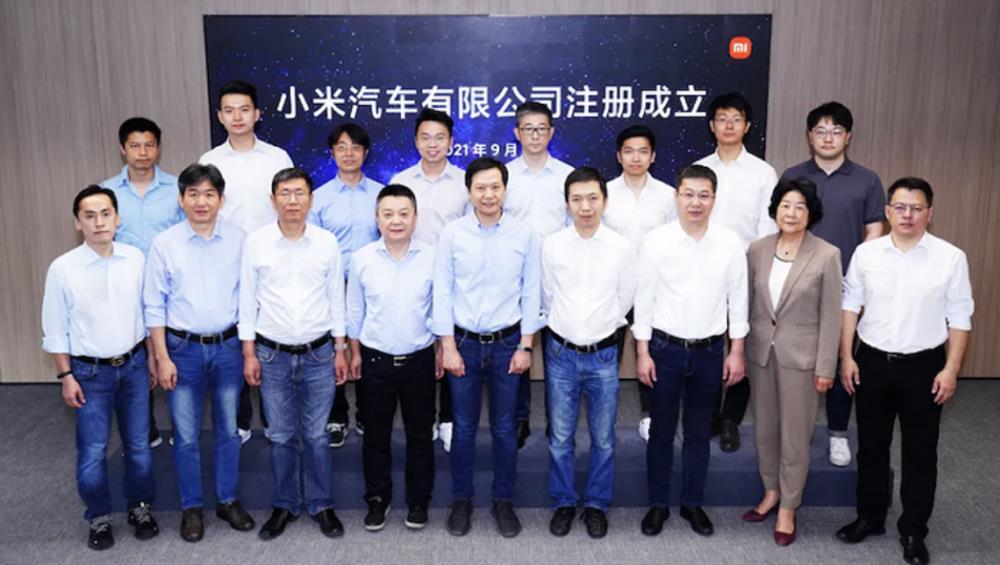
53. On August 25th, Xiaomi acquired Shendong Technology, an autonomous driving technology company, for 500 million yuan.
On August 25th, Xiaomi Group announced that it would acquire DeepMotion Tech Limited, an autonomous driving technology company, with a total transaction amount of about US$ 77.37 million (about RMB 503 million). After the transaction is completed, Deep Motion Technology will become a wholly-owned subsidiary of Xiaomi.
According to the data, Shendong Technology was founded in July 2017. It is a provider of autonomous driving solutions that mainly provide perception, positioning and decision-making with high-precision maps as the core. At present, the next generation of stereoscopic vision ADAS equipment and the next generation of high-precision visual crowdsourcing maps for autonomous driving are being developed.
Lin Bin, the co-founder and vice chairman of Xiaomi, then took a photo in Weibo, saying, "I am very happy that several old Microsoft colleagues have joined Xiaomi to build a car!"
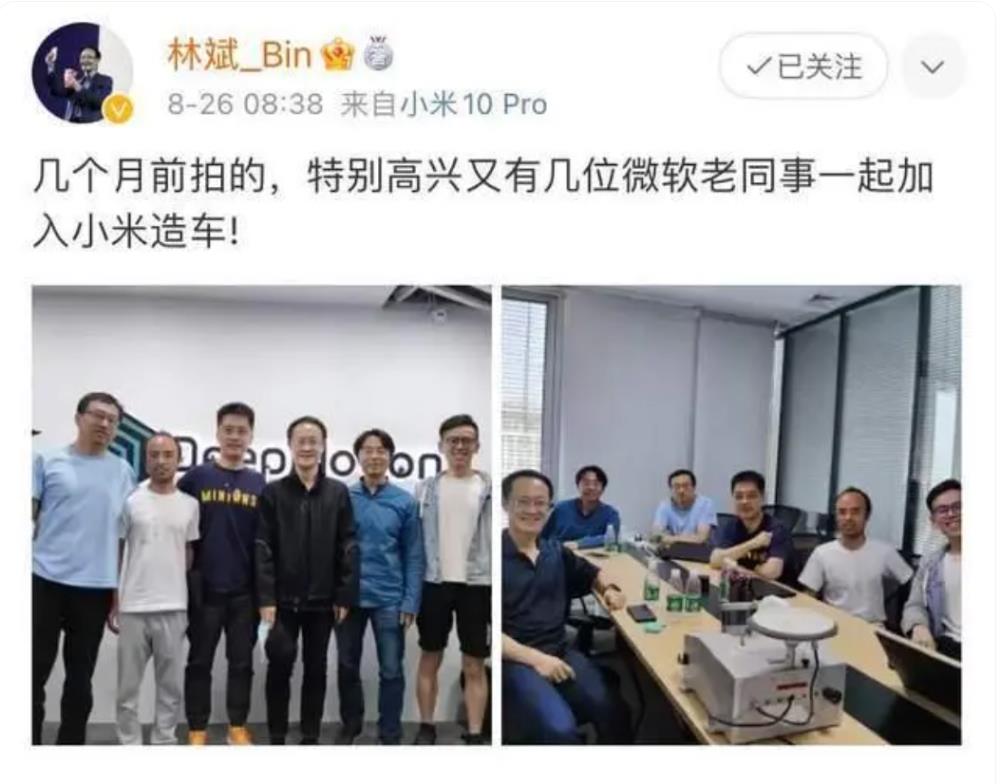
54. On August 23rd, Wisdom Interchange (Love Parking) announced that it had obtained the strategic investment from Xiaomi Group.
?
55. On August 18th, Xiaomi officially took a stake in Honeycomb Energy.
Another big move of Xiaomi about automobile energy is to become an important shareholder of Honeycomb Energy, a new energy company, with a capital contribution of 100 million yuan in the B round of financing.
Honeycomb Energy was born out of the power battery department of Great Wall Motor, and officially became independent in February 2018. After relying on the new energy automobile brand Euler Automobile under Great Wall to achieve the installed capacity growth in the early stage, it continued to expand its production capacity, and obtained sales points including Geely Automobile, Dongfeng Motor and Zero Run Automobile. At the same time, it signed a sales contract of 10 billion yuan with Stellantis, the fourth largest automobile group in the world, and entered the European and American markets.
In the first half of 2021, the domestic installed capacity of Honeycomb Energy was 0.84GWh, ranking seventh.
?
56. On August 2nd, Geometry Partners received nearly 400 million yuan in financing: Xiaomi Changjiang Industrial Fund led the investment.
?
57. On July 30, Ganfeng Lithium Industry: its subsidiary, Ganfeng Lithium Battery, plans to absorb investors such as Xiaomi Production and Investment to increase capital.
On July 30th, Ganfeng Lithium Industry announced the announcement that Jiangxi Ganfeng Battery Technology Co., Ltd., a subsidiary, absorbed investors’ capital increase. Among them, the name of Xiaomi Production and Investment is included in the list of investors, and it is the leading party, with an investment amount of 187.5 million yuan and a registered capital of 75 million yuan. After the capital increase is completed, the shareholding ratio of Xiaomi Production and Investment is 3.51%.
According to the data, Ganfeng Lithium Battery was established in 2013. Its parent company, Ganfeng Lithium Industry, is the leader in the domestic lithium industry and the international lithium compound (lithium salt) deep processing industry. At present, its lithium hydroxide production capacity is 85,000 tons, ranking first in the country.
?
58. On June 8th, Hesai Technology completed a new round of financing, with Xiaomi as one of the leading investors.
The domestic lidar start-up company, Wo Sai Technology, announced that it has completed financing of over 300 million US dollars, and one of the leading investors is Xiaomi Group.
Founded in 2013, Hesai Technology is also a leading enterprise in the field of laser radar in China. Whether it is an early mechanical laser radar or a popular hybrid solid-state laser radar, Hesai’s products have reached cooperation with most domestic autonomous driving and vehicle companies, including Baidu, Wen Yuan Zhixing and LI.
?
59. On June 3, 2011, Xiaomi took the initiative to complete the D round of $190 million financing.
On June 3, Zongmu Technology, an autonomous driving technology company, announced the completion of the D round of financing of 190 million US dollars, in which the D1 round was led by Denso Japan, the D2 round was led by Tongchuang Weiye and Gaoyuan Capital, and the D3 round was led by Xiaomi Changjiang Industrial Fund.
Founded in 2013, Zongmu Technology is also the first enterprise invested by Xiaomi officially after the vehicle was built. It is positioned as a supplier of technologies and products for automatic driving system ADS and advanced driver assistance system ADAS, and its products cover core sensor products such as ADS/ADAS domain controller, camera, millimeter wave radar and ultrasonic radar.
Attached is an information sorting table:
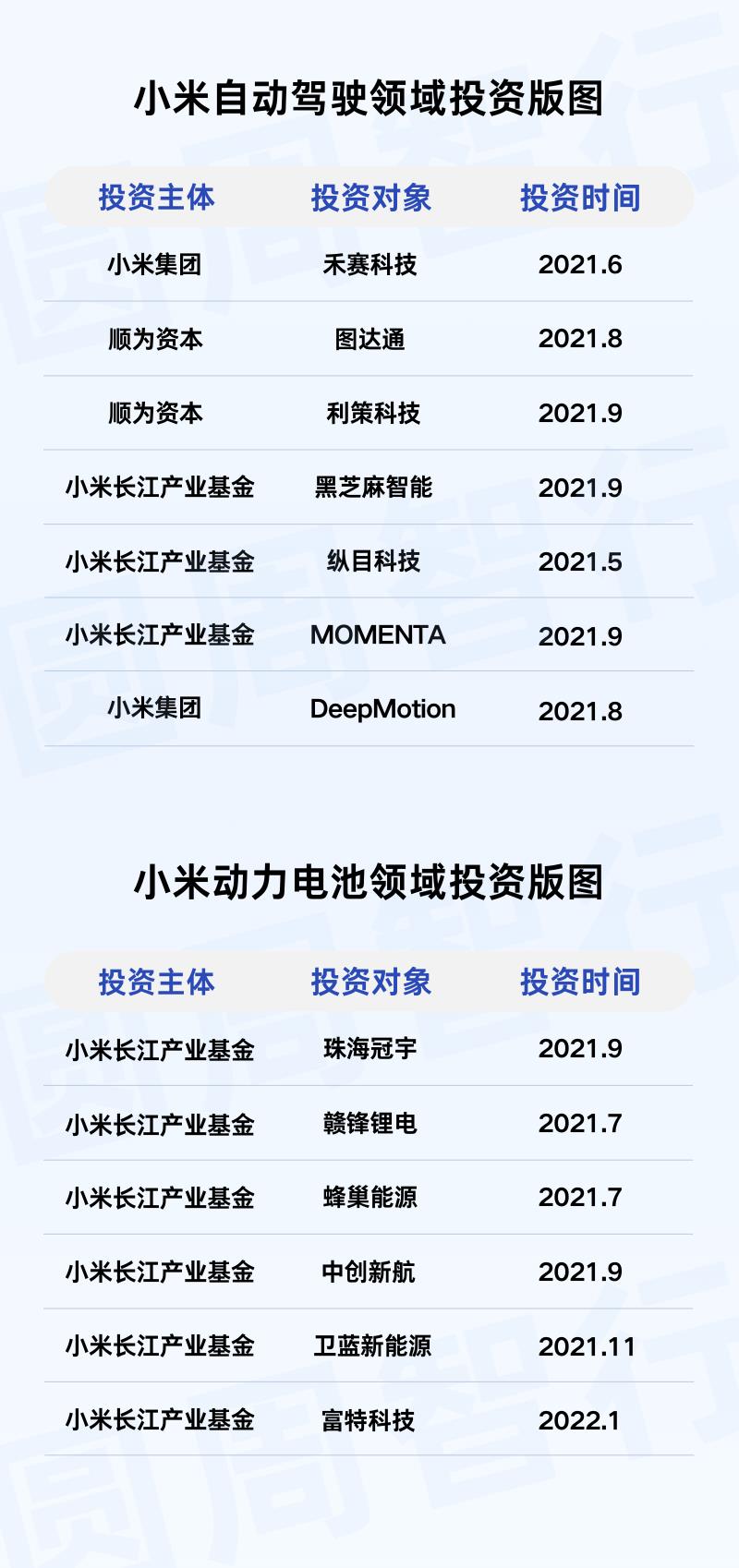
?60. On April 6, 2011, Lei Jun talked about Xiaomi making cars again: the first car tended to be a car or SUV.
On April 6th, Lei Jun, the chairman of Xiaomi, responded to the car-making plan again in the live broadcast of "Xiaomi 11th Anniversary Special Event". Lei Jun said that Xiaomi’s first model will tend to be a car or SUV, and the pricing is likely to be in the range of 100,000 yuan to 300,000 yuan that rice noodles are most expected.
A few days ago, regarding the model of the first car, Xiaomi’s survey showed that 45% of users wanted Xiaomi’s first car to be a car, 40% wanted an SUV, 7-8% wanted a sports car, and 5-6% wanted an RV.

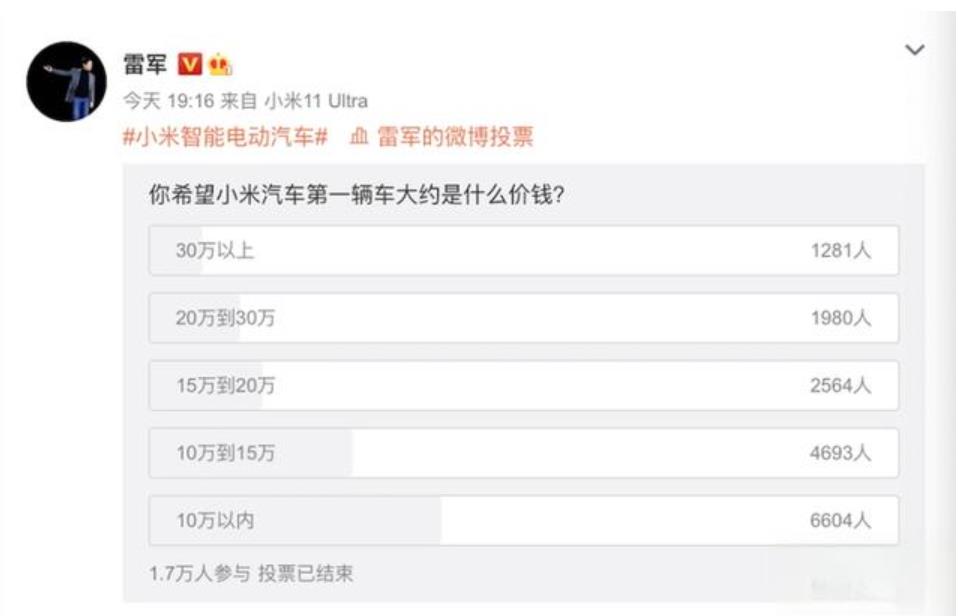
On March 30, 61, 2001, Lei Jun took the lead and officially entered the automobile industry to fight for Xiaomi Automobile.
On March 30th, at the Xiaomi conference, Lei Jun officially announced that Xiaomi would formally enter the automobile manufacturing industry.
At the same time, Xiaomi announced on the Hong Kong Stock Exchange that "the board of directors of our company officially approved the establishment of the smart electric vehicle business. The company set up a wholly-owned subsidiary to be responsible for the smart electric vehicle business. The initial investment is 10 billion RMB, and it is estimated that the investment will be 10 billion USD in the next 10 years. Mr. Lei Jun, CEO of the Group, will also be the CEO of the smart electric vehicle business, thus officially opening the road for Xiaomi to build a car.
As early as 2013, Lei Jun visited Tesla CEO Musk twice, expressing great curiosity about electric vehicles. In 2014, Lei Jun also participated in the establishment of Weilai Automobile through Shunwei Capital, and in 2016, he participated in a series of actions such as financing in Xpeng Motors. It can be seen that Xiaomi officially entered the automobile industry by no accident.














































